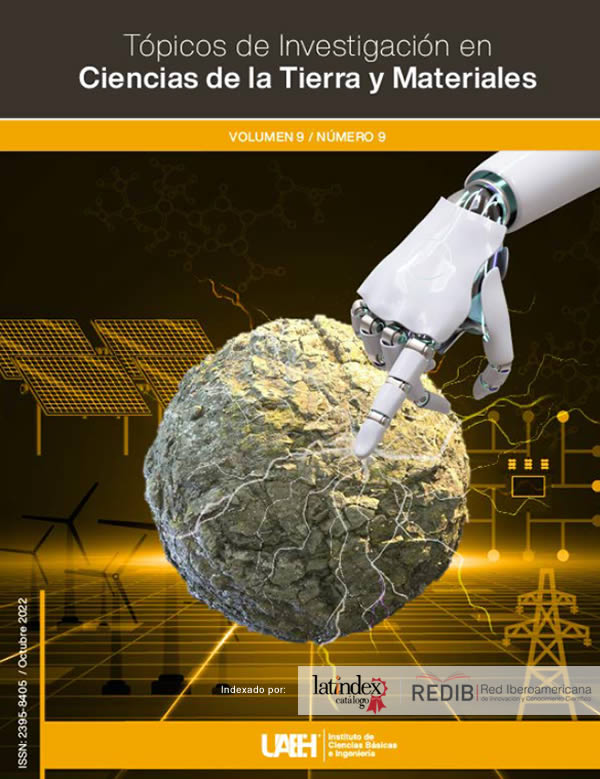Determination of the base system for silver recovery analysis by thiosulfate ion using high purity reagents: silver nitrate, silver chloride and metal shot
DOI:
https://doi.org/10.29057/aactm.v9i9.9064Keywords:
Thiosulfate, Silver leaching, Particle size, Solubility, silver recoveryAbstract
During the last decades, the study of thiosulfate as an alternative to cyanide in the recovery process of precious metals has become very relevant due to its sustainability. In the present work, the behavior of high purity reagents: metal shot, silver nitrate and silver chloride was analyzed in order to determine a base system that could serve as a starting point for future research using thiosulfate as a complexing agent. X-Ray Diffraction (XRD) and Scanning Electron Microscopy (SEM) characterized the reagents. The best results were obtained using metal shot generating 6.4% silver recovered using the following experimental conditions: solution volume = 0. 5 L, [S2O32-] =10 g∙L-1, [NaOH] =0.01mol∙L-1, [Ag] = 2 g∙L-1, stirring speed= 700 min-1, temperature = 298 K, pH= 10, Partial Pressure of O2= 1 atm, reaction time= 24 h.
Downloads
Publication Facts
Reviewer profiles N/A
Author statements
Indexed in
- Academic society
- N/A
References
Briones, R., & Lapidus, G. T. (1998). The leaching of silver sulfide with the thiosulfate–ammonia–cupric ion system. Hydrometallurgy, 50(3), 243-260.
Estadística Mensual de la Industria Minerometalúrgica de 2020. INEGI
, Feng, D., & Van Deventer, J. S. J. (2007). The role of oxygen in thiosulphate leaching of gold. Hydrometallurgy, 85(2-4), 193-202
Jeffrey, M. I., Breuer, P. L., & Choo, W. L. (2001). A kinetic study that compares the leaching of gold in the cyanide, thiosulfate, and chloride systems. Metallurgical and Materials Transactions B, 32(6), 979-986.
Landero, I. R. (2003). Estudio cinético de la precipitación lixiviación de plata en el sistema o2-s2o3 2--s2o4 2-. Aplicación en efluentes industriales (Doctoral dissertation, Universitat de Barcelona).
Luna, R. M., & Lapidus, G. T. (2000). Cyanidation kinetics of silver sulfide. Hydrometallurgy, 56(2), 171-188.
Milla González, M. (2016). Equilibrios heterogéneos. Influencia de la complejación en la solubilidad. Solubilización del cloruro de plata en medio amoniacal
Muir, D. M., & Aylmore, M. G. (2004). Thiosulphate as an alternative to cyanide for gold processing–issues and impediments. Mineral processing and extractive metallurgy, 113(1), 2-12.
Newhall, B., & McCauley, A. (2002). Historia de la fotografía. Gustavo Gili.
Smith, J.M.; Ingeniería de la Cinética Química, 1ra edición, Mc Graw-Hill, 1991, 7, 146-158.
Teja,A.(2018). Estudio termodinámico y cinética de la selectividad de plata contenida en un concentrado de Zn empleando tiosulfato en medio NaOH y Ca(OH)2.Tesis de doctorado. Universidad Autónoma del Estado de Hidalgo, México.
Teja-Ruiz, A. M., Reyes-Domínguez, I. A., Acevedo-Sandoval, O. A., Palacios-Beas, E. G., Flores-Guerrero, M. U., Pérez-Labra, M., & Juárez-Tapia, J. C. (2020). Silver leaching from miargyrite (AgSbS2) sulfosalt in the system S2O32--Ca (OH) 2: Kinetic analysis and experimental design approach. Hydrometallurgy, 198, 105456.


















